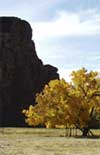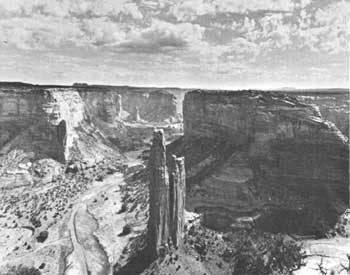





Survey of Historic Sites and Buildings
 |
CANYON DE CHELLY NATIONAL MONUMENT Arizona |
 |
| ||
Typifying the colorful Indian country of the Southwest, this national monument is of outstanding archeological and historical significance. Embracing more than 130 square miles, it consists of awesome steep-walled canyons and sheer 1,000-foot-high red sand stone cliffs that have sheltered the prehistoric Pueblo and historic Navajo Indians for thousands of years.
Tucked away in the recesses of Canyon de Chelly, nestled below towering cliffs or perched on high ledges, are the ruins of several hundred ancient villages. Dating from A.D. 350 to 1300, the ruins include Basketmaker (350-700) circular pithouses; aboveground Pueblo (700-1300) stone rectangular dwellings connected into compact villages; and Pueblo cliff houses, most dating from the 1100-1300 era.
 |
| Canyon de Chelly National Monument, historic Navajo stronghold. Spider Rock in foreground. (photo by Fred Mang, Jr., National Park Service) |
About 1300 climatic and perhaps other adverse factors forced the bulk of the Pueblo occupants, as well as those residing in the Four Corners region of Arizona, Utah, Colorado, and New Mexico, to disperse to other parts of the Southwest. Some of the present-day Pueblo Indians of Arizona and New Mexico are descendants of these prehistoric peoples. The canyons continued to be sporadically occupied by the Hopi Indians, also Puebloan.
About 1700 the Navajo Indians, an aggressive people who were culturally and linguistically related to the Apaches, began to emigrate from northern New Mexico to northeastern Arizona around Canyon de Chelly. For a century and a half they raided the Pueblo villages and Spanish settlements along the upper Rio Grande Valley. As the various governments of New Mexico-Spanish, Mexican, and American—intensified reprisals, Canyon de Chelly became a major Navajo stronghold.
In 1863-64 Col. "Kit" Carson, under the direction of Gen. James H. Carleton of the California Volunteers, who occupied Arizona and New Mexico during the Civil War, conducted a full-scale campaign against the Navajos following his roundup of the Mescalero Apaches. Proceeding from Fort Wingate, N. Mex., Carson established Fort Canby, Ariz., as a base of operations. Harrying the Navajos and killing their sheep, he reduced them to near starvation. They took refuge in the supposedly impregnable fortress of Canyon de Chelly. There Carson's cavalrymen completed the subjugation. Under military escort about 8,000 half-starved people made the "Long Walk" to the Bosque Redondo Reservation in eastern New Mexico, where they joined the Mescaleros. The Navajos endured great suffering before the Government allowed them in 1868 to return to their ancestral homeland in northeastern Arizona.
Today within the national monument some Navajo families, scattered in hogans on the canyon floors, live a simple pastoral life much as they did in Carson's time. Flocks of sheep graze in the canyon and on the rims, though sheepherding has declined. The majority of the tribe are now salaried employees. Many prehistoric pictographs are visible on the cliff faces and in rock shelters. Formerly, National Park Service personnel provided guided tours of the national monument; tours can now be arranged with Navajo guides.
 |
 |
http://www.cr.nps.gov/history/online_books/soldier-brave/sitea2.htm
Last Updated: 19-Aug-2005